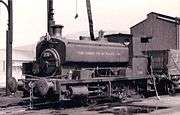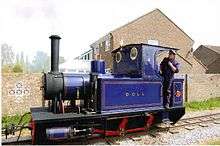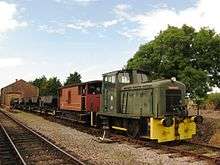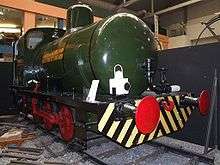Andrew Barclay Sons & Co.
| Industry | Engineering |
|---|---|
| Predecessor | Barclays & Co. |
| Successor |
Hunslet-Barclay (1972) Brush-Barclay (2007) Wabtec Rail Scotland (2011) |
| Founded | 1892 |
| Headquarters | Kilmarnock, Scotland |
| Products | Locomotives |
| Owner | Wabtec |
.jpg)
Andrew Barclay Sons & Co. are a builder of steam and later fireless and diesel locomotives. The company's history dates to foundation of an engineering workshop in 1840 in Kilmarnock, Scotland.
After a long period of operation the company was acquired by the Hunslet group in 1972 and renamed Hunslet-Barclay; in 2007 the company changed hands after bankruptcy becoming Brush-Barclay as part of the FKI Group. In 2011 Brush Traction and Brush-Barclay were acquired from FKI by Wabtec - as of 2012 the company still operates in Kilmarnock providing rail engineering services as Wabtec Rail Scotland.
History
Born in 1814, Andrew Barclay was only 25 years of age when he set up a partnership with Thomas McCulloch to manufacture mill shafts in Kilmarnock, East Ayrshire, Scotland. It was only a couple of years later that he branched out on his own to manufacture his patented gas lamps. In 1847 he set up workshops specializing in the manufacture of winding engines for the local coal mining industry. However, the money from the gas lamp patent sale was never paid and sequestration of the company came the following year.
By 1859 Barclay had recovered from this setback and his newly formed company produced its first locomotive. Sometime around 1871 Andrew Barclay set up a second locomotive building business known as Barclays & Co. He had set up this company for his younger brother, John, and his four sons. This business remaining closely associated with Andrew Barclay. Again not all went well and the companies were declared bankrupt in 1874 and 1882 respectively. Four years after this latest collapse, Andrew Barclay’s business was relaunched as Andrew Barclay Sons & Co. Later Barclays & Co was also revived. Further difficulties arose. In 1892 the firm became a limited liability company as Andrew Barclay Sons & Co., Ltd. Just two years later Andrew was removed from control of the company which bore his name by its shareholders. Barclay sued the company for unpaid wages, a matter which was settled out of court 5 years later.
In 1930 the company bought the business of John Cochrane (Barrhead) Ltd, engine makers and in 1963 it acquired the goodwill of the North British Locomotive Company, Glasgow.
Hunslet-Barclay
In 1972 the company was acquired by the Leeds-based Hunslet Group of companies and its name was changed in 1989 to Hunslet-Barclay Ltd. As such, it operated six ex-British Rail Class 20 diesels to provide motive power for weed-killing trains used on the national rail network. The locomotive interests of Hunslet-Barclay were bought by LH Group, Staffordshire on 31 December 2003, with Hunslet-Barclay at Kilmarnock continuing in the business of design, manufacture and refurbishment of multiple units, rolling stock, bogies and wheel-sets.
Some Barclay locomotives were supplied through Lennox Lange, who acted as an agent for Barclay.
Brush-Barclay
After going into financial administration in 2007 the company was acquired by the locomotive builder Brush Traction of Loughborough through its parent, the FKI Group.[1] It was renamed Brush-Barclay.[2]
Wabtec Rail Scotland
On 28 February 2011, Wabtec announced that it had acquired Brush Traction for US$31 million. The Kilmarnock works became Wabtec Rail Scotland.[3][4]
Products
Saddle tanks
The company was noted for constructing simple robust locomotives, chiefly for industrial use, and many of its products survive in use on heritage railways, over 100 in Britain. A typical product would be an 0-4-0 with squared-off saddle tank.
Fireless locomotives
Barclay was the largest builder of fireless locomotives in Britain, building 114 of them between 1913 and 1961. Few fireless locomotives are seen in action today. This is due to the low power of the locomotives, the long time needed to charge a locomotive from cold and the low steam pressures available for charging. Perhaps the only exception was "Lord Ashfield" (Andrew Barclay works no. 1989 of 1930) at the Museum of Science and Industry in Manchester that ran for a while in the 1990s sharing a steam supply with the stationary exhibits in their exhibition hall.
Diesel locomotives
The company built diesel shunting locomotives for industry and for British Rail. Classes included British Rail Class D2/5, British Rail Class 01 and British Rail Class 06.
Export
Over 80 Andrew Barclay locomotives were supplied to railways in Ireland (Irish Turf Board/Bord na Móna), Australia, New Zealand, Fiji and Sri Lanka (Sri Lanka Port Authority).[5]
Preservation
.jpg)
.jpg)
.jpg)
.jpg)
.jpg)
A large number of various ABS&Co locomotives have been preserved, proving popular on many Heritage Railways and Railway Centres, as listed below.
Standard Gauge
'Steam Locomotives'
- No' 699 "Swanscombe" - Preserved and running at the Buckinghamshire Railway Centre, Quainton Road in Buckinghamshire
- No' 776 "Firefly" - Preserved and under restoration on the Northampton and Lamport Railway in Northampton.
- No' 782 "Kinlet" - Preserved and on display at Blists Hill Victorian Town
- No' 807 "Bon Accord" - Preserved and undergoing overhaul on the Royal Deeside Railway in Scotland
- No' 880 Crane Tank "Glenfield No' 1" - Preserved and currently awaiting restoration at the Ribble Steam Railway in Lancashire
- No' 885 - Preserved and awaiting restoration at the Cambrian Heritage Railway in Oswestry, Shropshire
- No' 945 "Annie" - Preserved and currently under overhaul at the Whitwell & Reepham Railway in Norfolk
- No' 1015 "Horden" - Preserved and currently under restoration at Tanfield Railway in County Durham, North-East England
- No' 1047 "Storefield" - Preserved and running at the East Anglian Railway Museum in Essex
- No' 1142 NCB "No' 29" - Preserved and undergoing restoration by the Shed 47 railway restoration group in Scotland
- No' 1147 "John Howe" - Preserved and on Display on the Ribble Steam Railway in Lancashire
- No' 1116 Dalemellington "No' 16" - Preserved and on Display at the Scottish Industrial Railway Centre in Scotland
- No' 1175 NCB "No' 8 Dardanelles" - Preserved and on Display at Polkemmet Country Park in Scotland
- No' 1193 Lady Victoria Colliery "No' 6" - Preserved and awaiting restoration at the Tanfield Railway in County Durham, North-East England
- No' 1219 "Caledonia Works" - Preserved and running on the West Somerset Railway in Somerset
- No' 1223 "Colin MacAndrew" - Preserved and on Display on the Chasewater Railway in Staffordshire
- No' 1245 - Preserved and running on the Lakeside & Haverthwaite Railway in Cumbria
- No' 1260 "Forester" - Preserved and undergoing restoration on the Pontypool & Blaenavon Railway in Wales
- No' 1338 Dalmellington Iron Co. "No' 17" - Preserved and awaiting a major overhaul at the Llangollen Railway in North-East Wales
- No’ 1385 “Rosyth No. 1” - Preserved and running on the Pontypool and Blaenavon Railway in Wales
- No' 1398 "Lord Fisher" - Preserved and running at the Yeovil Railway Centre in Somerset
- No' 1458 "No' 3 Lady Victoria" - Preserved and awaiting restoration at the Bo'ness & Kinneil Railway in Scotland
- No' 1472 "Bluebottle" - Preserved and on Display at the Bressingham Steam and Gardens in Norfolk
- No' 1473 "Sir Charles" - Preserved and on Display at the Swansea Industrial and Maritime Museum in Wales
- No' 1477 - Preserved and on Static Display at the Buckinghamshire Railway Centre
- No' 1550 "Sir James" - Now on Static Display at HM Factory, Gretna
- No' 1572 Heysham "No' 1 Lancaster" - Preserved and awaiting restoration at Carnforth in Lancashire
- No' 1598 "Efficient" - Preserved and on Display at the Ribble Steam Railway in Lancashire
- No' 1605 "W38 Ajax" - Preserved and on Display on the Isle of Wight Steam Railway on the Isle of Wight
- No' 1614 Dalmellington "No' 19" - Preserved and awaiting restoration at the Scottish Industrial Railway Centre in Scotland
- No' 1619 NCB "Toto No' 6" - Preserved and undergoing restoration at the Mangapps Railway Museum in Essex
- No' 1659 "No' 32" - Preserved and undergoing overhaul at the Cromford and High Peak Railway in Derbyshire
- No' 1680 "Nora No' 5" - Preserved and currently static at the Big Pit National Coal Museum, in Wales
- No' 1719 "Lady Nan" - Preserved and running on the East Somerset Railway in Somerset
- No' 1823 "Harry" - Preserved and awaiting restoration at the Pontypool & Blaenavon Railway in Wales
- No' 1833 "Niddrie" - Preserved and under restoration at the Ribble Steam Railway in Lancashire
- No' 1863 - Preserved and running at the Caledonian Railway (Brechin) in Scotland
- No' 1865 "Alexander" - Preserved and on Display at the Ribble Steam Railway in Lancashire
- No' 1874 "Maite" - Preserved at the Azpeitia Railway Museum in Basque Country, Spain
- No' 1875 Crane Tank "Stanton No' 24" - Preserved and on Display inside the Matthew Kirtley Museum, on the Midland Railway – Butterley in Derbyshire
- No' 1876 - Preserved and on Display at the Sittingbourne and Kemsley Light Railway in Kent
- No' 1889 Aberdeen Gas Works "No' 3" - Preserved and on Display at the Grampian Transport Museum in Scotland
- No' 1890 Granton Gasworks "Forth No' 10" - Preserved and running on the Fife Heritage Railway in Scotland
- No' 1927 B.C.G.D "No' 1" - Preserved and on Display at the Bury Transport Museum in Greater Manchester
- No' 1931 - Preserved and running at the Rutland Railway Museum near Leicestershire
- No' 1937 Clyde's Mill "No' 3" - Preserved and on Display at the Bo'ness & Kinneil Railway in Scotland
- No' 1950 "Heysham No. 2" - Preserved and on Display at the Ribble Steam Railway in Lancashire
- No' 1952 Shell Refining "No' 8" - Preserved and running at the Scottish Industrial Railway Centre in Scotland
- No' 1964 "Spitfire" - Preserved and running on the Lincolnshire Wolds Railway in Lincolnshire
- No' 1969 "JN Derbyshire" - Preserved and on Display at the Ribble Steam Railway in Lancashire
- No' 1984 "Boots No' 1" - Preserved and undergoing restoration at the West Somerset Railway in Somerset
- No' 1989 "Lord Ashfield" - Preserved and awaiting overhaul at the Bo'ness & Kinneil Railway in Scotland
- No' 2008 "Boots No' 2" - Preserved and on Display inside the Matthew Kirtley Museum, on the Midland Railway – Butterley in Derbyshire
- No' 2015 "Tom Parry" Preserved and awaiting restoration at Pontypool & Blaenavon Railway in Wales
- No' 2017 "Braeriach No' 17" - Preserved and awaiting overhaul at the Strathspey Railway in Scotland
- No' 2020 Balmenach Distillery "No' 2" - Preserved and awaiting overhaul at the Strathspey Railway in Scotland
- No' 2043 NCB "No' 6" - Preserved and running at the Bo'ness and Kinneil Railway in Scotland
- No' 2047 "No' 705" - Preserved and running on the Plym Valley Railway in Devon
- No' 2046 British Aluminium Co. "No' 3" - Preserved and awaiting restoration at the Bo'ness & Kinneil Railway in Scotland
- No’ 2068 “No’ 20” ex Wemyss - Preserved and awaiting overhaul at the Bo'ness & Kinneil Railway in Scotland
- No’ 2069 “Little Barford”
- No' 2073 "Dailuaine No' 1" - Preserved and on display at Aberfeldy distillery in Scotland
- No' 2074 "Llantarnam Abbey" - Preserved and undergoing restoration at the Pontypool & Blaenavon Railway in Wales
- No' 2086 Royal Ordinance Factory "Drake" - Preserved and on Display at Andrew Barclay Railway Centre in Scotland
- No' 2088 "Sir Thomas Royden" - Preserved and running at the Rutland Railway Museum near Leicestershire
- No' 2107 "Harlaxton" - Preserved and running on the Caledonian Railway (Brechin) in Scotland
- No' 2127 Crane Tank "No' 6" - Preserved and currently on display in the museum at the Bo'ness & Kinneil Railway in Scotland
- No' 2134 British Gypsum "W.T.T." - Preserved and stored at Carnforth in Lancashire
- No' 2138 "Swordfish" - Preserved and running on the Swindon & Cricklade Railway in Wiltshire
- No' 2139 "Salmon" - Preserved and running on the Royal Deeside Railway in Scotland
- No' 2157 "Fambridge" - Preserved and running on the Mangapps Railway Museum in Essex
- No' 2168 "Edmundsons" - Preserved and under overhaul at the Rushden Transport Museum in Northamptonshire
- No' 2183 "Earl David No' 15" - Preserved and running on the Avon Valley Railway in Gloucestershire
- No' 2199 - Preserved and running at the Whitwell & Reepham Railway in Norfolk
- No' 2201 "Victory" - Preserved and awaiting restoration at the Pontypool & Blaenavon Railway in Wales
- No' 2217 "Henry Ellison" - Preserved and running on the Ecclesbourne Valley Railway in Derbyshire
- No' 2219 NCB "No' 17" - Preserved and awaiting overhaul at the Prestongrange Museum in Scotland
- No' 2220 "Invicta" - Preserved and under restoration at the Chatham Historic Dockyard Railway in Kent
- No' 2221 - Preserved and awaiting restoration at the Dean Forest Railway in Gloucestershire
- No' 2226 "Katie" - Preserved and awaiting a major overhaul at the Churnet Valley Railway in Staffordshire
- No' 2230 Cook and Nuttall "No' 1 Hurricane" - preserved and undergoing overhaul at Carnforth in Lancashire
- No' 2238 BP Chemicals - Preserved and on Display at the Welsh Industrial and Maritime Museum in Wales
- No' 2239 "Mr Therm" - Preserved and on static display at Seaton Park.
- No' 2243 - Preserved and on Static Display at the Buckinghamshire Railway Centre
- No' 2244 NCB "No' 10" - Preserved and running at the Scottish Industrial Railway Centre in Scotland
- No' 2248 "Albert" - Preserved and under overhaul on the Plym Valley Railway in Devon
- No' 2258 "Tiny" - Preserved and on Display at the Keighley and Worth Valley Railway in Yorkshire
- No' 2260 NCB "No' 23" - Preserved and on Display at the Scottish Industrial Railway Centre in Scotland
- No' 2264 "Fife Flyer No' 6" - Preserved and running at the Cambrian Heritage Railway in Oswestry, Shropshire
- No' 2268 Glaxo Laboratories "Glaxo" - Preserved and awaiting restoration at Carnforth
- No' 2274 NCB "No' 22" - Preserved and awaiting overhaul on the Bowes Railway, Tyne & Wear, North-East England
- No' 2284 NCB "No' 21" - Preserved and awaiting overhaul at the Lady Victoria Colliery in Scotland
- No' 2292 NCB "No' 21" -Preserved and undergoing restoration at the Fife Heritage Railway in Scotland
- No' 2296 NCB "No' 17" - Preserved and undergoing restoration at the Scottish Vintage Bus Museum in Scotland
- No' 2315 "Lady Ingrid" - Preserved and currently being overhauled at the Spa Valley Railway in Kent/Sussex
- No' 2320 NCB "No' 22" - Preserved and under overhaul at the Embsay & Bolton Abbey Steam Railway, in North Yorkshire
- No' 2323 - preserved and awaiting restoration at Rushden Transport Museum in Northamptonshire
- No' 2333 "David" - Preserved and under overhaul at the Lakeside and Haverthwaite Railway in the Lake District
- No' 2335 NCB "No' 24" - Preserved and on Display at the Bo'ness & Kinneil Railway in Scotland
- No' 2343 "British Gypsum No'4" - Preserved and currently awaiting restoration at the Ribble Steam Railway in Lancashire
- No' 2350 "Belvoir" - Preserved and awaiting restoration at the Rutland Railway Museum near Leicestershire
- No' 2352 GEPG Goldington "No. 67 Hong Kong Flyer" - Preserved and undergoing restoration at the Tanat Valley Railway in Shropshire
- No' 2354 "Richard Trevithick" - Preserved and undergoing overhaul on the Swindon & Cricklade Railway in Wiltshire
- No' 2358 NCB "No' 25" - Preserved and awaiting restoration at the Scottish Industrial Railway Centre in Scotland
- No' 2360 "Brian Harrison No' 3" - Preserved and running on the Ecclesbourne Valley Railway in Derbyshire
- No' 2361 "W.S.T" - Preserved and awaiting an overhaul on the Bowes Railway in Tyne & Wear, North-East England
- No' 2368 NCB "No' 1" - Preserved and awaiting restoration at the Scottish Industrial Railway Centre in Scotland
- No' 2369 - Preserved and under overhaul at the Appleby Frodingham Railway Preservation Society in Lincolnshire
- No' 2373 Imperial Paper Mills "No' 1" - preserved and on Display at the National Railway Museum in York
'Diesel Locomotives'
- "Powfoot" No' 1 - Preserved and Operational at the Scottish Industrial Railway Centre.
- "Meaford" No' 2 - Preserved and Operates as a regular shunter on the Embsay and Bolton Abbey Steam Railway, in North Yorkshire.
- DH No' 1 - Preserved and Operates as a shunter on the West Somerset Railway.
- DH No' 2 - Preserved and Operates as a shunter on the West Somerset Railway.
- DM No' 7 - Preserved and Operational at the Scottish Industrial Railway Centre.
- DM No' 15 - Preserved and Operational on the Lavender Line, in Sussex.
- DM No' 28 "Bardon" - Preserved and operates as station pilot at Rothley on the Great Central Railway, in Leicestershire.
- No' 333 "John Peel" - Preserved and Operates at the East Anglia Railway Museum, in Essex.
- No' 349 - Preserved and Operates on the Colne Valley Railway, in Essex.
- No' 357/WD42 "Overload" - Preserved and currently on static display, at the Chatham Historic Dockyard Railway, in Kent.
- No' 415 - Preserved and Operational on the Royal Deeside Railway.
- No' 416 - Preserved and currently being overhauled on the Midland Railway - Butterley in Derbyshire.
- No' 422 "Hot Wheels" - Preserved, but currently stored out of use on the Battlefield Line Railway in Leicestershire.
- No' 441 - Preserved and currently undergoing repairs on the Midland Railway - Butterley in Derbyshire.
- No' 446 "Kingswood" - Preserved and Operational on the Avon Valley Railway, in Gloucestershire.
- No' 486 "Clive" No' 4 - Preserved and currently being overhauled at the Foxfield Railway, in Staffordshire.
- No' 517 "Power of Enterprise" - Preserved, though currently stored out of use on the Strathspey Railway.
- No' 615 - Preserved and currently at the Aln Valley Railway, in Northumberland.
- No' 70043 "Grumpy" - Preserved and Operational on the Avon Valley Railway, in Gloucestershire.
- No' 421697 - Preserved and currently awaiting cosmetic restoration at the Scottish Industrial Railway Centre.
Narrow Gauge
'Steam Locomotives'
- No' 2 LM44 - Preserved and running on the Stradbally Woodland Railway in Ireland.
- No' 3 Darent - Preserved and running on the Kempton Steam Railway in Hounslow, West End of London.
- No' 3 Shane - Preserved and running on the Giant's Causeway and Bushmills Railway in Ireland.
- No' 4 Doll - Preserved and running on the Leighton Buzzard Light Railway in Bedfordshire.
- No' 6 Douglas - Preserved and running on the Talyllyn Railway in Wales.
- No' 8 Dougal - Preserved and running on the Welshpool and Llanfair Light Railway in Mid-Wales.
- No' 9 Jack - Preserved and running somewhere in Reading, Berkshire.
- Cegin - Preserved and awaiting restoration at the Statfold Barn Railway in Staffordshire.
- Gertrude - Preserved and running on the Welsh Highland Heritage Railway in North Wales.
'Diesel Locomotives'
Gallery




See also
- Grant, Ritchie and Company - In 1876, there was a disastrous fire at Andrew Barclay’s Caledonia works in Kilmarnock. At this point, two employees Thomas Grant and William Ritchie, set up Grant, Ritchie and Company at Townholme Engine Works, Kilmarnock to manufacture steam locomotives.[6][7]
References
- ↑ "£2.1m deal puts Hunslet -Barclay back on the rails", Herald Scotland, 13 November 2007
- ↑ "Brush buys Hunslet-Barclay". Railway Gazette International. 25 November 2007.
- ↑ "Wabtec buys Brush Traction". Railway Gazette International. 28 February 2011.
- ↑ Samuel, A. (28 February 2011), "Wabtec Rail announces acquisition of Brush Traction Group", www.rail.co, archived from the original on 9 September 2012
- ↑ Australian Railway Historical Society Bulletin, June 1984, pp.121-136
- ↑ 272 Grant Ritchie 272/1894 Check
|url=value (help), Ribble Steam Railway, retrieved 14 January 2012 - ↑ "British locomotive manufacturers", wwww.steamindex.com, Grant Ritchie & Co., Townholme Engine Works, Kilmarnock, retrieved 12 January 2012
Further reading
- Wear, Russell (1990). Barclay 150: a brief history of Andrew Barclay, Sons & Co. Ltd. and Hunslet-Barclay Ltd., Kilmarnock from 1840 to 1990. Kilmarnock: Hunslet-Barclay.
- Wear, Russell (1977). The Locomotive Builders of Kilmarnock. Industrial Railway Society.
External links
| Wikimedia Commons has media related to Andrew Barclay Sons and Company. |